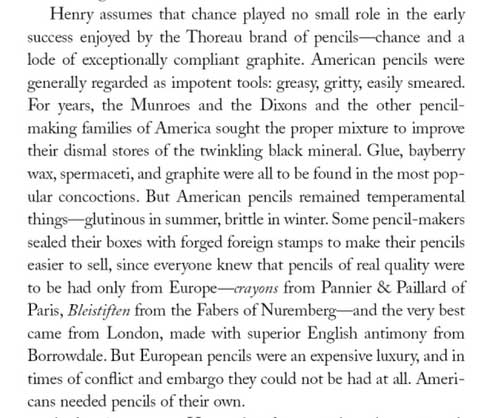“Then to Hoppe’s for pencils English for Ann”
31. July 1839
It’s no coincidence that Anne is specific about the pencils’ origin/type. As you can read in this excerpt from the novel “Woodsburner: A Novel” by John Pipkin (2009) (page 117), the English pencil was clearly always considered superior:

Here is an extract from wikipedia:
As a technique for drawing, the closest predecessor to the pencil was silverpoint until in 1565 (some sources say as early as 1500), a large deposit of graphite was discovered on the approach to Grey Knotts from the hamlet of Seathwaite in Borrowdale parish, Cumbria, England.This particular deposit of graphite was extremely pure and solid, and it could easily be sawn into sticks. It remains the only large-scale deposit of graphite ever found in this solid form. Chemistry was in its infancy and the substance was thought to be a form of lead. Consequently, it was called plumbago (Latin for “lead ore”). Because the pencil core is still referred to as “lead”, or “a lead”, many people have the misconception that the graphite in the pencil is lead, and the black core of pencils is still referred to as lead, even though it never contained the element lead. The words for pencil in German (bleistift), Irish (peann luaidhe), Arabic (قلم رصاص qalam raṣāṣ), and some other languages literally mean lead pen.
The value of graphite would soon be realised to be enormous, mainly because it could be used to line the moulds for cannonballs; the mines were taken over by the Crown and were guarded. When sufficient stores of graphite had been accumulated, the mines were flooded to prevent theft until more was required.
The usefulness of graphite for pencils was discovered as well, but graphite for pencils had to be smuggled. Because graphite is soft, it requires some form of encasement. Graphite sticks were initially wrapped in string or sheepskin for stability.
England would enjoy a monopoly on the production of pencils until a method of reconstituting the graphite powder was found in 1662 in Italy. However, the distinctively square English pencils continued to be made with sticks cut from natural graphite into the 1860s. The town of Keswick, near the original findings of block graphite, still manufactures pencils, the factory also being the location of the Cumberland Pencil Museum